
* During World War II, Consolidated built a larger and more advanced flying boat, the four-engine "Coronado", though it did not prove as successful. After the war, Convair -- as Consolidated had become after a merger with Vultee aircraft -- built a very large flying boat, the "Tradewind", but it did not prove successful.
* Even as the PBY Catalina was entering Navy service, the US Navy was seeking a more formidable four-engine flying board, with the Navy ordering single prototypes of the Consolidated "Model 29" or "XPB2Y-1", and the Sikorsky "XPBS-1" in 1936. The Sikorsky prototype performed its initial flight on 9 September 1937, with the Consolidated prototype performing its initial flight on 17 December 1937. The Navy selected the XPB2Y-1 for the requirement.
The Sikorsky XPBS-1 was not put into production, though it did lead to three "VS-44" trans-oceanic "clipper" flying boats. The XPBS-1 did a stint as the "Flagship of Aircraft, Scouting Fleet, US Navy", and was later was put into transport service, being lost in a landing on 30 June 1942, hitting a submerged log -- one crew member being killed, Admiral Chester Nimitz being slightly injured.
The XPB2Y-1 was a high-wing flying boat, with four engines and a conventional tail assembly -- plus a prominent prow that suggested it was built for ramming. The engines were 14-cylinder, two-row P&W XR-1830-72 Twin Wasp air-cooled radials providing 780 kW (1,050 HP) each. It was armed with a single 12.7-millimeter (0.50-caliber) Browning machine gun in nose and tail positions, plus a single 7.62-millimeter (0.30-caliber) Browning in a beam position on each side of the rear fuselage.
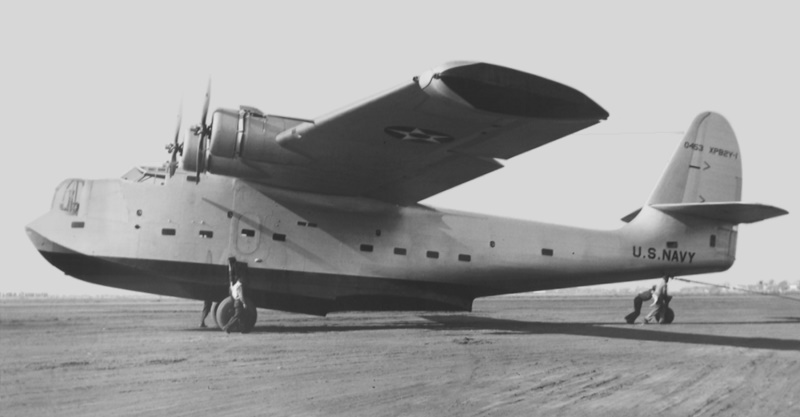
Evaluation of the prototype led to the initial-production "PB2Y-2", with the twin tail -- though the endplates were lozenge-shaped, like those of the Consolidated B-24 Liberator. There was also considerable redesign of the fuselage, the most significant change being elimination of the ungainly prow, as part of the redesign of the boat hull; the XPB2Y-1's water handling left something to be desired, the new hull being well deeper than the old. The PB2Y-2 was powered by R-1830-78 Twin Wasps with 760 kW (1,200 HP) each, and had defensive armament of six 12.7-millimeter Browning machine guns -- it appears two in a nose turret, the other four being in the tail, on each beam position, and in a new dorsal cupola.
Only six PB2Y-2s were built, the variant being intended for evaluation. The PB2Y-2 led to the "PB2Y-3", which featured armor protection and self-sealing tanks. A PB2Y-2 was converted to "XPB2Y-3" configuration as a prototype for the series. The PB2Y-3 was powered by R-1830-88 Twin Wasps with 890 kW (1,200 HP) each, driving three-bladed Hamilton Standard variable props, and had a normal crew of nine.
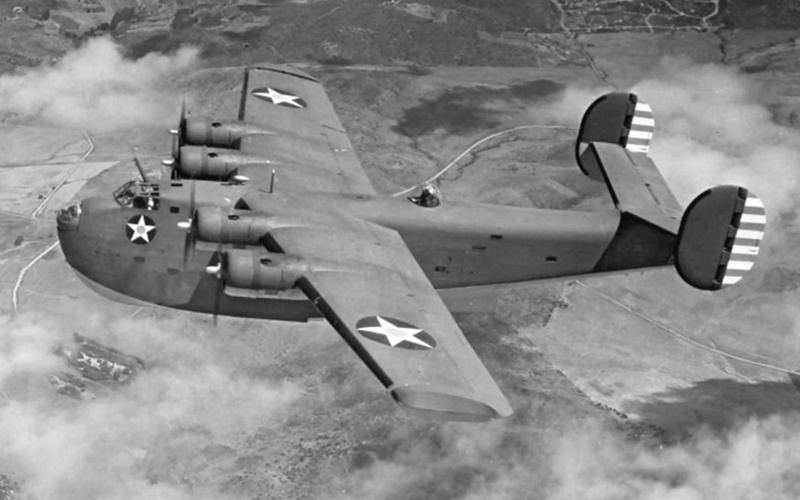
Defensive armament was eight 12.7 millimeter guns -- two guns each in nose, tail, and dorsal turrets, plus a flexibly-mounted gun in a beam position on each side. Total warload, carried in bays in the inner wings, was 5,440 kilograms (12,000 pounds), including:
Aircraft handling was judged acceptable by crews, though the controls were notably heavy and tiring -- an issue that also affected the Consolidated B-24 Liberator. The PB2Y-3 entered service in early 1942, with 210 built to end of series production in 1944. Late-production PB2Y-3s featured search radar in a prominent dorsal radome behind the cockpit.
___________________________________________________________________
CONSOLIDATED PB2Y-3 CORONADO:
___________________________________________________________________
wingspan:
35 meters (115 feet)
wing area:
175.4 sq_meters (1,780 sq_feet)
length:
24.2 meters (79 feet 3 inches)
height:
8.4 meters (26 feet 6 inches)
empty weight:
18,570 kilograms (40,935 pounds)
MTO weight:
30,845 kilograms (68,000 pounds)
max speed at altitude:
360 KPH (225 MPH / 195 KT)
service ceiling:
6,250 meters (20,500 feet)
range:
3,815 kilometers (2,370 MI / 2,060 NMI)
___________________________________________________________________
The PB2Y-3 did fly anti-submarine patrols and served as a long-range bomber -- notably in raids on Wake Island in early 1944. However, it wasn't really well-suited to ocean patrols, having less than half the range of the Catalina. During 1944, the PB2Y-3 was replaced in the patrol role by PB4Y-1 (B-24) Liberator. The PB2Y-3 was primarily used as a transport by the Naval Air Transport Service (NATS). 31 PB2Y-3s were converted by Rohr Aircraft Corporation to "PB2Y-3R" transports, with faired-over turrets, re-routed control runs, a cargo loading hatch, a reinforced floor with tie-down rings to secure cargo, seats for 44 passengers, and a maximum cargo capacity of 7,255 kilograms (16,000 pounds).
The R-1830-88 engines, with two-stage superchargers, were replaced by R-1830-92 engines with single-stage superchargers, the transports not needing high-altitude performance. The PB2Y-3Rs also had increased fuel capacity and provision for rocket assisted take-off gear (RATOG), the rockets being used to reduce take-off run.
An "XPBY-4" was converted from a PB2Y-3 by re-engining it with Wright R-2600 dual Cyclone radials, with 1,200 kW (1,600 HP) each, providing better performance -- but not enough to make it worth putting into production. A number, how many is not clear, of PB2Y-3 patrol bombers were upgraded to "PB2Y-5" standard by refitting them with the low-altitude R-1830-92 engines. They also featured increased fuel capacity, raised from 8,410 to 11,520 liters (1,910 to 3,040 US gallons), increasing typical operational range from 2,205 to 2,640 kilometers (1,370 to 1,640 miles). In addition, the PB2Y-5s could be fitted with RATOG rockets.
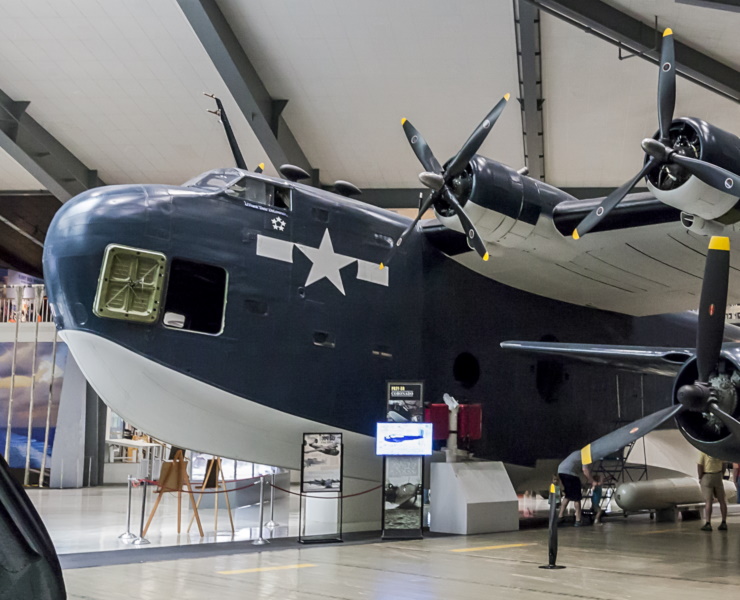
Some PB2Y-5s were converted to unarmed transports under the designation of "PB2Y-5R", with some of these fitted out for medical evacuation with accommodations for 25 litters, plus medical attendants. The medical evacuation PB2Y-5Rs were apparently at least informally designated "PB2Y-5H". It is unclear how many conversions to PB2Y-5/R/H configuration were performed.
Britain was to obtain 32 PB2Y-3s -- actually "PB2Y-3s", with some minor changes -- but only obtained ten, designating them "Coronado General Reconnaissance Mark I (GR.I)". They were originally intended for anti-submarine warfare; as with the US, they ended up as transports, with the turrets ultimately faired over. In the postwar period, all the Coronados save one were soon scrapped, or in some cases scuttled, the only survivor now being on display at the US Navy air museum in Pensacola, Florida.
BACK_TO_TOP* In 1943, Consolidated merged with Vultee Aircraft to become "Consolidated Vultee" -- or "Convair" for short, though that wasn't the official name for some years. In any case, in 1945 the US Navy issued a request for a big flying boat to feature the latest technology, notably turboprop engines. Its primary mission was to be long-range maritime patrol, with secondary missions including air-sea rescue, anti-submarine patrol, and anti-ship attack.
A number of companies submitted proposals, with the Convair proposal "Model 117" emerging as the winner. The Navy accordingly issued a contract to Convair in 1946 for two "XP5Y-1" prototypes, one an initial prototype, the other to pre-production spec. Following extensive tests with models, the initial XP5Y-1 prototype performed its first flight on 18 April 1950, from San Diego.
As envisioned, the XP5Y-1 was a big, high-wing flying boat with a stepped hull, straight tapered wings and tailplane, a tall tailfin with a prominent forward fillet, fixed floats, a raised cockpit, and a nose radome. The boat hull was based on advanced research by the US National Advisory Committee for Aeronautics (NACA, the primary ancestor of the modern NASA). Most significantly for the future of the program, the XP5Y-1 was powered by the Allison XT40 turboprop -- a "twin-pac" engine, consisting of dual turboprops driving a set of three-bladed contra-rotating Hamilton Standard props, each 4.6 meters (15 feet 1 inch) in diameter. Each T-40 could, in principle, provide 3,800 kW (5,100 HP). Aircraft development was protracted due to problems with the engines.
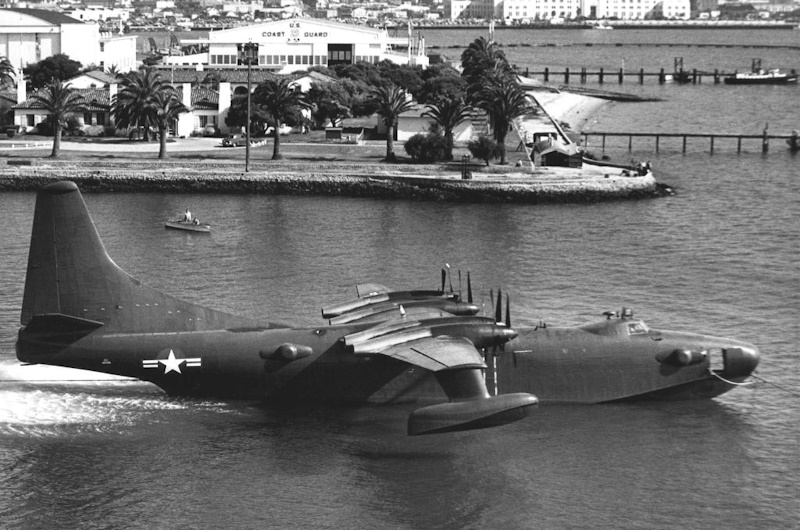
The production machines being envisioned for the antisubmarine warfare (ASW) / maritime patrol role, the XP5Y-1 could carry 3,625 kilograms (8,000 pounds) of stores, including bombs, mines, depth charges, and torpedoes. They were to have defensive armament of ten 20-millimeter cannon, mounted in pairs on turrets on the side of the fuselage, fore and aft on each side, and a tail turret. Some sources claim they were to be fitted with 12.7-millimeter Brownings instead -- but it doesn't matter, since armament was never fitted in practice.
However, no production XP5Y-1 machines were built, the Lockheed P2V Neptune becoming the successful solution for the ASW / maritime patrol role. In fact, the second XP5Y-1 prototype was built but never got engines, to be eventually scrapped. The first prototype was lost in an accident in 1953, the crew escaping safely.
The Navy didn't give up on the concept, instead deciding to build the aircraft as a transport. Two versions of the "Tradewind", as it was named, were to be built: the "R3Y-1", a troop transport with a side loading door, and the "R3Y-2", a troop / equipment transport with an upward-hinging nose for access. In 1953, before the loss of the XP5Y-1 prototype, the Navy ordered five R3Y-1s and six R3Y-2s.
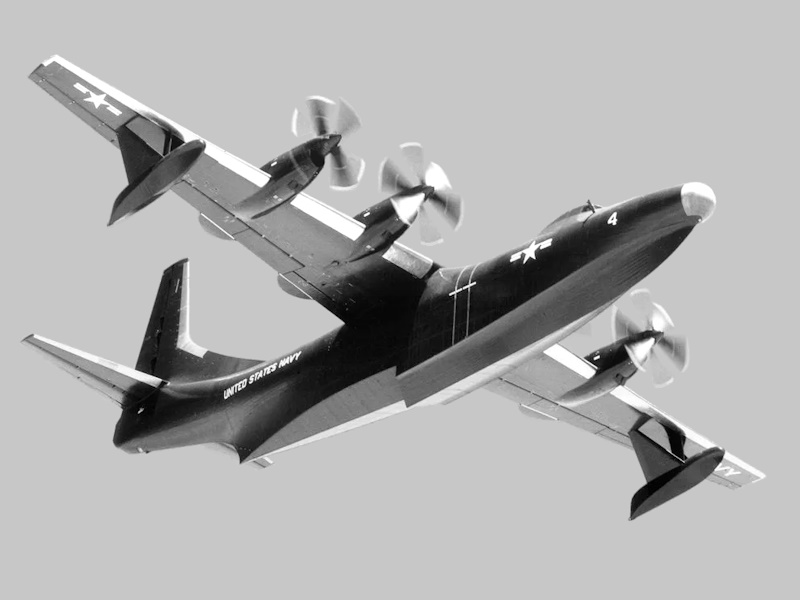
The R3Ys had no armament and featured a longer fuselage, plus the engine moved on top of the wings, instead of mated to them. They had pressurization and, along with seven flight crew, could carry 100 passengers, 22 tonnes (24 tons) of cargo, or 92 stretchers, over a range of 3,200 kilometers (2,000 kilometers). As a cargo carrier, the R3Y-1 could only handle crated or bagged cargo; the R3Y-2, with its tilt-up nose, could carry four 155-mm towed howitzers, six jeeps, or three 6x6 2.5-ton trucks. Convair promoted the R3Y-2 as a "flying Landing Ship, Tank (LST)" -- but that was a dubious notion, since it couldn't operate against a defended beach, and its beach management was somewhat uncertain.
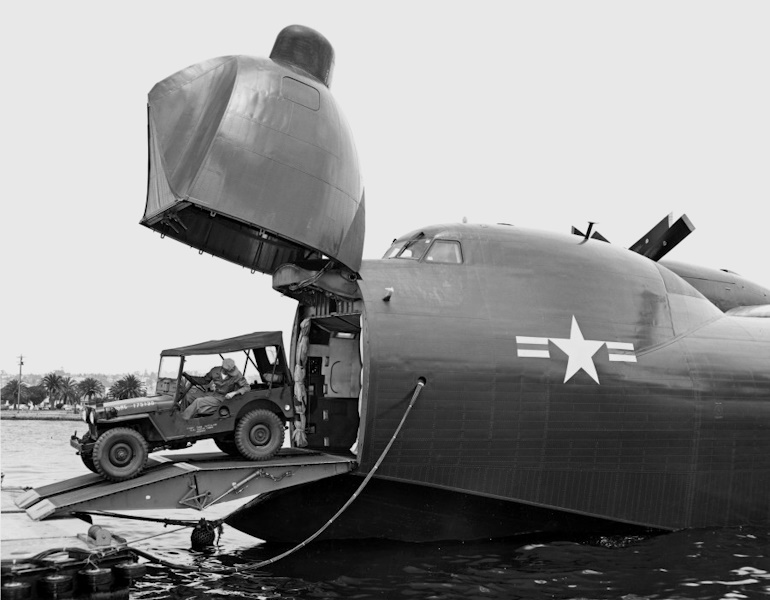
Initial flight of the first R3Y-1 was on 25 February 1954. The R3Y-2 followed on 22 October 1954. Seven of the eleven R3Y Tradewinds built were named for major bodies of water. The fourth R3Y, the "Coral Sea", set a transcontinental seaplane record flying from San Diego, California to Patuxent River, Maryland, in six hours, at an average speed of 648 KPH (403 MPH). Its speed was boosted by high-altitude jetstream winds. It was run through trials at Patuxent River, with three other Tradewinds going there over the next two years for further trials.
___________________________________________________________________
CONVAIR R3Y TRADEWIND:
___________________________________________________________________
wingspan:
44.44 meters (145 feet 2 inches)
wing area:
195.2 sq_meters (2,100 sq_feet)
length (R3Y-1):
42.58 meters (139 feet 8 inches)
length (R3Y-2):
43 meters (141 feet 2 inches)
height:
14.94 meters (49 feet)
empty weight:
32,580 kilograms (71,825 pounds)
MTO weight:
74,840 kilograms (165,000 pounds)
max speed at altitude:
580 KPH (360 MPH / 315 KT)
cruise speed:
480 KPH (300 MPH / 260 KT)
service ceiling, fully laden:
9,200 meters (30,300 feet)
ferry range:
5,550 kilometers (3,450 MI / 3,000 NMI)
___________________________________________________________________
All aircraft were delivered to USN Air Transport Squadron Two (VR-2) based at NAS Alameda, California, through 1956. They were to replace the unit's Martin Mars flying boats on the San Diego to Honolulu run. From 1956, one R3Y-1 and three R3Y-2 machines were modified as inflight refueling tankers with four hose-drogue pods each, one under each wingtip and under each outboard engine. They were in principle capable of refueling four Navy fighters simultaneously -- though trials showed the propwash from the engines was troublesome, and so the conclusion was to only use the wingtip pods. The trials otherwise went well, with thought of turning all the R3Ys into tankers.
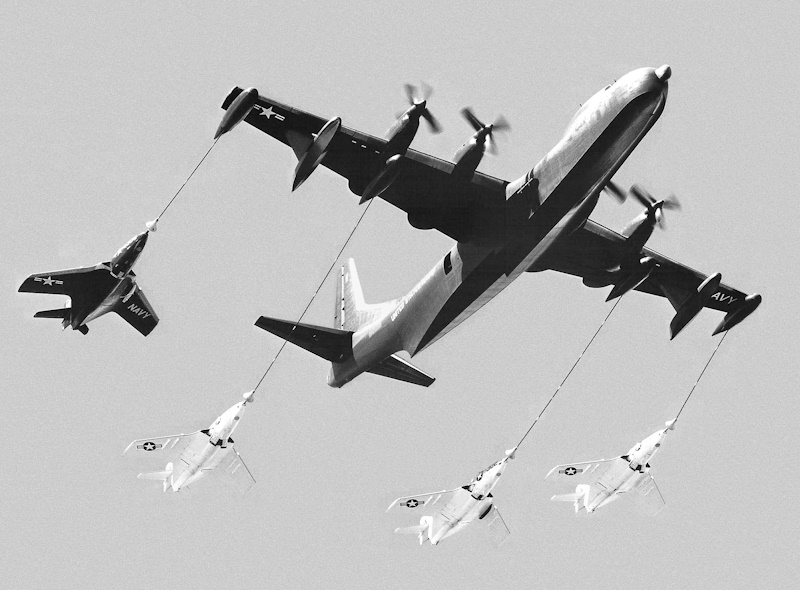
However, the R3Ys didn't have a future. Particularly at altitude, the dual engines in each twin-pac T40 had problems syncing up, leading to gearbox and prop failures; the service crews were always having to fix them. One R3Y was lost in 1957 after an engine failure and a rough landing at sea, with the aircraft sinking; the crew escaped safely. Another R3Y had a similar problem in early 1958, smashing into a seawall, the crew surviving. The R3Ys were promptly grounded. Convair talked about refitting them with better turboprops, but the Navy had endured enough, and all the surviving R3Ys were eventually scrapped. Some commenters have suggested that, with better engines, the Tradewind would have proved very useful -- but in the postwar period, there were a number of efforts to build big flying boats, and they all came to nothing. The really big flying boat was an idea whose time had passed.
BACK_TO_TOP* Sources include:

* Illustrations details:
* Revision history:
v1.0.0 / 01 may 18 v1.0.1 / 01 apr 20 / Review & polish. v1.0.2 / 01 apr 22 / Review & polish. v2.0.0 / 01 apr 24 / Added Tradewind, went to two chapters.BACK_TO_TOP
